|
1.
CENTRAL/ WEST AFRICA
West Africa prices unchanged despite market concerns
No changes were reported for West African log export
prices, which have now held steady over the past few
weeks. China and India continue as the major buyers and
apart from a few relatively minor recent adjustments due
to demand pressures, prices for the main species have
remained remarkably steady over recent months. Despite
the rather gloomy forecasts for the US and European
economies, the timber trade has not so far discerned any
major effects, though West African exporters are
expressing some concern that sawn lumber prices may be
vulnerable should signs of real economic downturn begin
to impact construction and associated trades through the
second quarter. Log prices are more likely to remain
steady as supply is curtailed through the full
implementation of the quota system in Gabon. The latest
reports are that the quota is now in place and producers
and exporters are subject to the quotas being finalized.
The quota system in Congo Brazzaville has been in force
for some months and affected the total supply available for
export from the region. Equatorial Guinea recently
announced a total ban on log exports from its much
depleted forest resources. However, there are reports that
logs are still being exported. It is not yet clear whether this
is only the completion of existing contracts or if the ban is
being flouted.
For sawn lumber, prices are also unchanged. Exporters
nervous over competition from lower priced Malaysian
meranti have not seen their fears realized and demand
from Europe for the favorite species is within the normal
range for the winter season. Sapele supply is still very
much tighter than in the past because of the lower
availability in recent months from Central African
Republic, while sipo is in normal high demand, especially
from German buyers.
House sales in the UK have slowed but the overall
shortfall in the number of new houses being constructed is
to be addressed by government plans for up to 3 million
new houses to be built, some on controversial Greenfield
sites over the next few years. Though this would benefit
mainly the suppliers of structural softwoods, there would
be demand for new furniture and fittings in hardwoods,
including the fashionable solid wood flooring. There are
some signs that the hardwood flooring market in the UK
has slowed recently, with stronger competition forcing
prices lower. This far down the product line it could be
quite some time before any major effect was felt in the
West African supply countries.
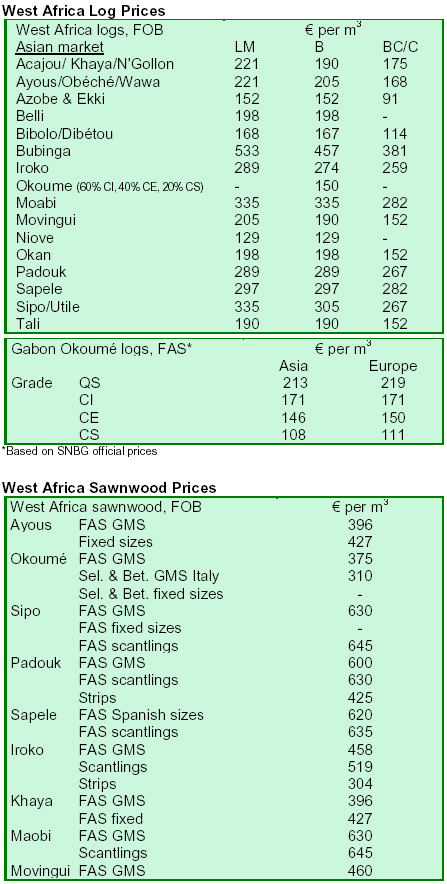
2. GHANA

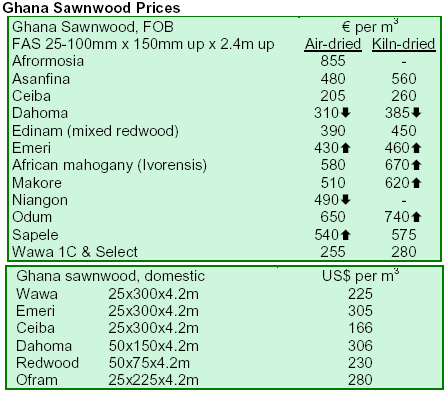
3.
MALAYSIA
Prices steady as market lulls during Chinese New Year
Prices of Malaysian timber products steadied as the market
closed for the annual Chinese Lunar New Year. Exporters
continued to be optimistic about price stabilization in the
near future as the next general election would take place
early next month. However, experts in Asian markets
expressed concern over stock prices on Wall Street and
were of the opinion that the US may indeed be heading
toward a recession.
In addition, Weyerhaeuser Co., the largest US lumber
producer, chalked up a fourth quarter loss of USD63
million after shutting down lumber mills and slashing
output as a slump in residential real estate deepened. This
adds fuel to the fire that the US market for Malaysian
timber products such as wooden furniture may be in
serious trouble.

4.
INDONESIA
Indonesia lowers economic growth forecast
According to various news sources, the Indonesian
government has lowered the country¡¯s projected economic
growth for 2008. In 2007, the government suggested that
the economic growth rate may be as high as 6.8%,
although figures are now expected to be in the range of
6.4-6.7%. The expectations were revised amid soaring
global prices for crude oil and staple food commodities.
The Indonesian Finance Minister Sri Mulyani Indrawati
said inflationary pressure due to global commodity price
increases would have an impact on the country¡¯s
macroeconomic situation. Additionally, Indonesian
plywood manufacturers are watching the Japanese market
closely as the latest data showed a continual drop in the
Japanese market for imported plywood.
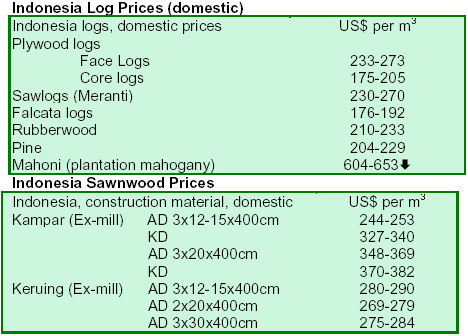
5.
MYANMAR
Myanmar timber prices reflect market¡¯s resiliency
Current export demand for teak is reported to be good.
However, prices for sawn quality log grades (SG4, SG5,
SG6 and SG7) have been going down steadily. A marked
drop can be seen in the SG4 and SG6 grades starting in
September 2007, with SG7 showing similar strains. SG4
logs serve a dual purpose: the first is to produce higher
quality sawn timber such as boards and planks, and the
second is for cutting veneer flitches. Veneer sheets are
then produced from the flitches and used as overlay on
other species of timber.
Some analysts presume that difficulties and the extra costs
associated with shipping sawn teak to Europe may be
instrumental in bringing down log prices. One experienced
trader said it would be difficult to ascertain where prices
are headed. Although prices have been on an upward trend
since the mid-1990s, erratic trends in prices are often seen.
Nevertheless, the market has shown resiliency over the last
decade and demand for timber continues to be steady.

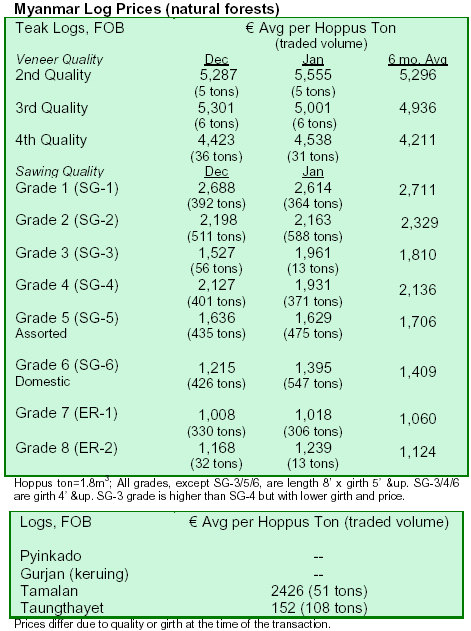
6. PAPUA
NEW GUINEA
PNG forest economist highlights export successes in 2007
A forest economist from the PNG Forest Authority
recently issued a report analyzing key export trends in
PNG log exports for 2007. Included in the analysis were
the following main points: the volume of log exports in
2007 increased by 7.5% (or 196,800 m3) compared to
2006; the value of log exports was 20% higher than in
2006 and amounted to USD203.9 million in 2007; the log
export tax benefit to the government was lower by 7.7%
compared to 2006 but still at record levels compared to
those achieved prior to 2006; and a new log export
development levy, implemented in November 2007, was
instituted at PNG K21.7 million.
The key reasons for the increased exports were the
commencement of new logging projects under Forest
Management Agreements and the reactivation of old nonoperational
projects. The value of logs had risen due to
higher prices charged for logs, which increased in value by
11.4% from the previous year¡¯s levels. The higher prices
were a result of higher demand for raw materials from fast
growing East Asian economies such as China and India.
Although the report mainly presented positive trends for
2007, it noted that the supply of timber from natural
tropical forest will continue to be an issue due to
international pressure to curb natural forest logging, forest
law enforcement and governance, forest certification
requirements and diminishing natural forest resources.
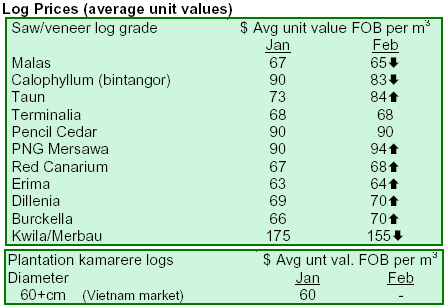
7.
BRAZIL
Members of timber sector fear stagnation in the
markets
S¡§® Not¡§ªcias has reported that timber companies in
Northern Brazil are anxiously waiting for the government
to enact measures to halt deforestation in the Amazon.
There are currently 100 mills operating in the Alta Floresta
region, a major logging cluster in the Amazon, and are
among those responsible for the Amazon¡¯s deforestation
over the last five years. According to the Timber Company
Union of the Far North (SIMENORTE), the sector awaits
new regulations and sector members fear stagnation.
Although cattle ranching and agricultural activities are the
major causes of deforestation, sector representatives also
suggest that if the new rules were to include prohibition of
forest management plans, the sector¡¯s prospects would
worsen.
In late January 2008, the Ministry of Environment started
a survey of legal reserves and permanent preservation
areas of properties in 36 municipalities with the largest
deforestation rates in Brazil. Alta Floresta and another
nine municipalities of the state of Mato Grosso are on the
list. The federal government has prohibited the opening of
new logging areas in 19 municipalities of Mato Grosso,
and announced the inspection of these areas will intensify
after mid-February, with 800 federal policemen to be sent
to the region. Some municipalities, such as Alta Floresta,
have not agreed with their inclusion in the list and officials
from the municipalities have denied any knowledge about
deforestation in their regions.
Outlook positive for furniture sector in 2008
Portal Moveleiro reported that the Brazilian furniture
sector faced difficulties in 2007 due to changes in financial
markets. Exports suffered because of the weakening US
dollar, reorienting sales to the domestic market.
Projections for the furniture sector for 2008 suggest low
inflation and a continuous decline of the prime interest
rate. According to the Sao Paulo Industry Federation
(FIESP), it is expected that the prime interest rate (SELIC)
will be reduced at least 2.0 percentile points by the end of
2008 (and it is currently at 11.25% annually). A reduction
in the rate will have a direct impact on credit lines for
consumers as well. The potential growth of the civil
construction and real estate markets will also have a strong
positive impact on the furniture sector since new or
remodeled houses encourage consumption of new
furniture, noted FIESP. Consequently, the prospects for
the sector are promising.
Southern Brazilian furniture cluster faces crisis
O Regional discussed developments in the Brazilian
furniture sector. Furniture exports in Brazil have been
facing a severe economic crisis in the last three years, with
a strong impact on the producing clusters in the Southern
region. The main reason is the falling US dollar that makes
profits for furniture companies relatively unattainable,
since export contracts of companies in the furniture sector
are set mainly in US dollars. The crisis in the sector has
evolved relatively fast, so as not to allow adequate time to
develop strategies to avert the problem. However, experts
are now working to devise strategies to counter the effects
of the falling US dollar on the furniture sector (see story
below).
Furthermore, there is a fierce competition between
furniture manufacturers around the world. According to
the Furniture Company Union of Bento Goncalves
(SINDMOVEIS), the trend seems clear and irreversible as
furniture exports by Chinese, Indian and European
manufacturers have gradually increased. Some actions to
make Southern Brazilian producers more competitive
include design innovation and use of alternative raw
materials and investing in new technology.
FIESP devises strategy to avert furniture export crisis
In November 2007, the Sao Paulo Industry Federation
(FIESP) presented a study suggesting measures to increase
competitiveness of the timber and furniture production
chain, said Portal Moveleiro. One recommendation in the
reports is to increase demand for furniture products and
reduce the offer of products in US dollars, which would
minimize the impact of the weakening US dollar. The
report¡¯s recommendations of the study are still under
consideration in the Central Bank of Brazil and the
Ministry of Finance.
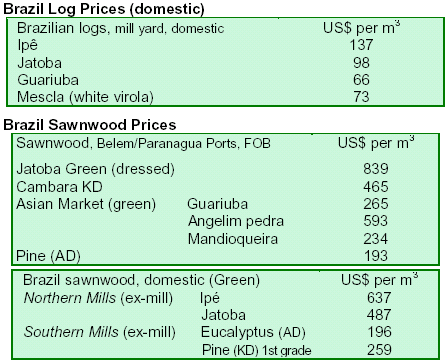
8. PERU
Peru¡¯s November 2007 exports fall
Peru¡¯s wood products exports in November 2007
decreased USD11.56 million when compared to the same
month in 2006. The drop in exports was due mainly to the
reduction of mahogany exports, the difficulty of exporting
to Chinese markets, and the US subprime mortgage crisis
and its impact on the markets, since Peru¡¯s main market is
the US. Peru¡¯s wood products exports also fell 4.84%
during January ¡§C November 2007, dropping in value from
USD197.25 million in 2006 to USD187.71 million in
2007.
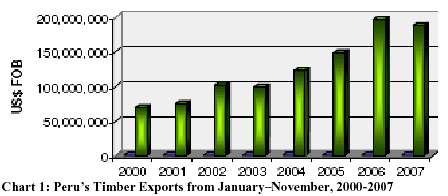
Items with the largest rise during the period January ¡§C
November 2007 period were furniture and components,
jumping 14.14%. Wood parquet and plywood items gained
12.98%. The growth of the furniture and components
subsector was caused by the growing amount of pieces and
components for furniture in the US market. On the other
hand, sawnwood exports decreased 11.71%. Exports of
fiberboard, chipboard, and veneer also fell since these
products were targeted to the domestic rather than the
export markets. Wood parquet and plywood rose slightly
in the period due to increased exports to Venezuela, Puerto
Rico and Ecuador.
Sawnwood was the main exported item, representing
20.86% of exports. However, the value of sawnwood
exports in 2007 fell by 11.71% from 2006 levels. In
November 2007, semi-manufactured products represented
26.5% of wood products exports and fell 4.36% in value
from the previous year¡¯s levels.

Exports of furniture and components jumped 14.14% from
January ¡§CNovember 2007 from the previous year¡¯s levels,
although exports in November 2007 decreased in value
USD231,357 compared to the same month in 2006.
Exports of wood parquet and plywood were up 12.9%
during the January- November 2007 period in contrast to
the same period in 2006.
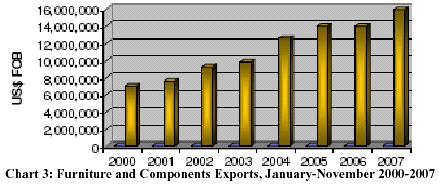
The US, Mexico and China continued to be the most
important destination markets of Peru¡¯s wood products
exports in both 2006 and 2007. Exports to the US and
China fell 23.35% and 9.55% respectively. Mexico¡¯s
imports from Peru increased 17.88% during 2007. While
the US, Mexico and China continued their strength as
Peru¡¯s main export markets, EU markets are gaining
importance, mainly due to the stronger Euro.
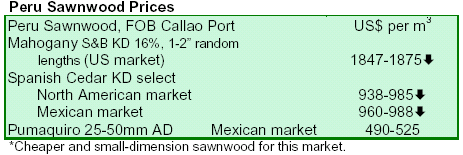
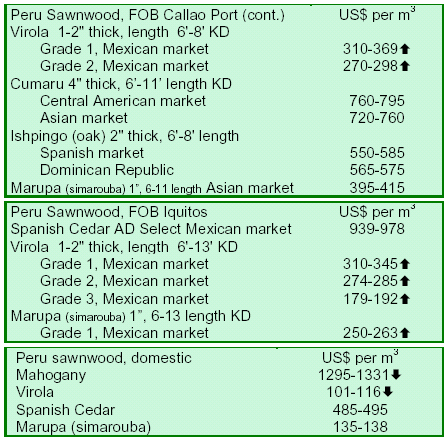
9. BOLIVIA

10.
Guyana
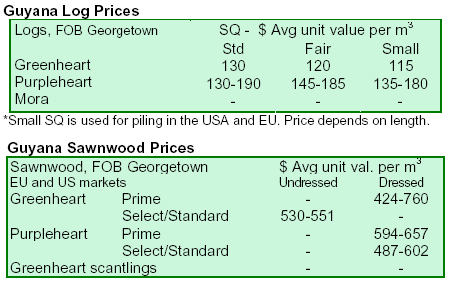
|